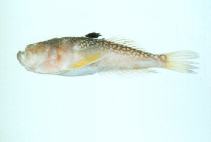| Family: |
Uranoscopidae (Stargazers) |
| Max. size: |
18 cm TL (male/unsexed) |
| Environment: |
bathydemersal; marine; depth range 250 - 300 m |
| Distribution: |
Western Pacific: southern Japan to the South China Sea except Ryukyu Islands. |
| Diagnosis: |
Dorsal spines (total): 4-6; Dorsal soft rays (total): 13-15; Anal soft rays: 13-15; Vertebrae: 26-26. Lower edge of preopercle with 3 spines, very rarely to be more. Labial fimbriae simple and poorly developed. Posterior nostril slitlike. Dorsoposterior margin of pectoral fin slightly concave; pectoral and caudal fins pale yellow in fresh specimens. Fifth proximal anal pterygiophore (the first to follow a complete haemal spine) usually inserts between the haemal spines of 13th and 14th vertebrae (Ref. 11439). |
| Biology: |
Found near shore, down to 260 m, on sand and sandy mud bottoms (Ref. 11230). Spend a large part of their time buried in the mud or sand with only their eyes and a portion of the mouth protruding (Ref. 4716). Cleithral spine with venom gland (Ref. 57406). |
| IUCN Red List Status: |
Least Concern (LC); Date assessed: 04 February 2009 Ref. (130435)
|
| Threat to humans: |
venomous |
Source and more info: www.fishbase.org. For personal, classroom, and other internal use only. Not for publication.
